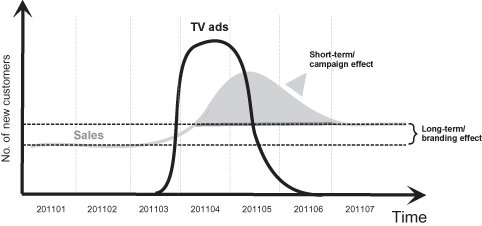CAMPAIGN-LEVEL PERFORMANCE TRACKING ON TIME-LIMITED CAMPAIGNS
If you used the decision tree in the beginning of this chapter (Exhibit 7.1), you were guided to this section because you want to learn how to set targets and optimize resources spent on campaigns that are not executed on a continuous basis. It is a characteristic of these campaigns that you do not know which of your new customers received the offer or the market communication. All you have from a data perspective is knowledge about your marketing activities and their aggregated effects (e.g., the increased number of customers in your customer base). This is a situation common to telecom operators, banks, insurance companies, magazine subscriptions, or charity organizations with member subscriptions, since they know the number of active customers they service.
Since the lag information presented in Exhibit 7.9 only describes a market intervention that lasted for a month and a half, we will not use forecasting models since they are used for describing long-term relationships between input and output variables. As a rule of thumb, a long-term relationship for forecasting models is three cyclic periods or more, where a period can be defined as years, months, weeks, or days, depending what you are trying to forecast and the data you have available.
Exhibit 7.9 Effects of a One-Off Campaign

The simplest way to test whether ...
Get Business Analytics for Sales and Marketing Managers: How to Compete in the Information Age now with the O’Reilly learning platform.
O’Reilly members experience books, live events, courses curated by job role, and more from O’Reilly and nearly 200 top publishers.

